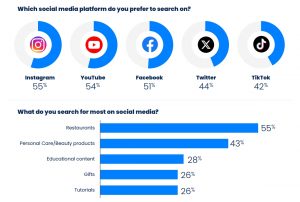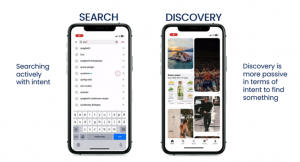Social Search: Focusing on the Consumer Journey, Not the Destination
- POV’s
- December 19, 2024
- Nicholas Jacobsen
The search landscape is rapidly evolving beyond traditional search engines. Social search is one example, becoming increasingly prevalent, with users turning to social media platforms like TikTok, Instagram, YouTube, and Pinterest to discover information, products, and services – everything from recipes to reviews – rather than relying solely on Google or Bing. By 2025, these platforms will be even more heavily driven by AI, video content, and integrated shopping experience.
Traditional Search vs. Social Search
Traditional search refers to the results you see on Google, regardless of whether they’re paid for or not. Social search, on the other hand, primarily relies on organic content, where posts are optimized using SEO principles.
However, some platforms, like TikTok, are beginning to offer keyword targeting options to supplement their standard targeting methods. This reflects a broader trend of increasing automation in social media advertising, with AI taking over tasks like ad creation, campaign setup, and optimization.
Some of the differences between the two platforms are summarized here:
| Traditional search | Social search (discovery) | |
| Intent: | Focuses on demand fulfillment | Emphasizes discovery and inspiration |
| Platforms: | Uses search engines | Occurs across diverse social media platforms |
| Format: | Produces web pages | Presents easily digestible posts, images, and videos |
| Influence: | Less influenced by social connections | Prioritizes recommendations from friends and influencers |
| Functionality: | Is a dedicated function | Integrates with other platform features |
| Advertising: | Uses keyword targeting | Utilizes a mix of keyword and contextual/behavioral targeting |
Why Social Search Matters
Social search aligns with evolving consumer behavior, particularly among younger demographics. In fact, according to an eMarketer June 2023 report, social networks have overtaken search engines as the primary preferred channel for brand research among global users aged 16-34. Platforms like TikTok, Instagram, and Pinterest are becoming primary discovery tools for Gen Z and Millennials, often replacing or supplementing traditional search engines for everything from product research to finding recipes and reviews. Brands must adapt to this shift by incorporating social search strategies to reach these audiences where they are already actively engaged, leveraging the power of social connections and recommendations to drive discovery and engagement.

From Search to Discover: Meeting Your Audience’s Needs
While positive customer experience and compelling content remain essential for achieving success on your website, understanding your audience and their needs is equally crucial. True success now depends on understanding your audience deeply and anticipating their needs. This includes understanding the shift towards more interactive and immersive experiences, moving beyond scrolling.
We know the search landscape is changing, and ensuring your brand is set up for success requires focus on the right areas. Here are some key points to consider and actionable steps you can take:
- Not All Platforms Are Relevant for Your Brand
Be selective. Focus your efforts on search engines and social platforms where your target audience is most active. This ensures your investment delivers meaningful results rather than spreading resources too thin. - Build a Strong Organic SEO Setup
A solid organic strategy enhances your visibility across both traditional and social search. High-quality content and technical SEO provide long-term benefits that go beyond paid efforts, ensuring your brand stands out where it matters. - Your Website is Central
Your website is your primary conversion hub. It needs to align with your broader search and social strategies. Focus on user experience, clear messaging, and seamless integration with your traffic sources to drive conversions effectively. - Embrace a Test-and-Learn Approach
Success in digital marketing comes from experimentation. Use a structured test-and-learn framework to identify what resonates with your audience. Whether it’s testing ad copy, targeting strategies, or content formats, these insights will guide smarter decisions. - Connect the Dots Between Channels
Consumers don’t view your brand in silos, and neither should you. Align your efforts across search (incl. social, AI engines and so on to create a consistent and impactful customer experience.
Navigating the evolving landscape of social search requires a proactive and adaptable approach. Staying ahead of platform-specific nuances, developing integrated cross-channel strategies, and seamlessly blending paid and organic efforts are key to maximizing your brand’s reach and engagement. At GroupM, we help brands navigate these challenges with an integrated, data-driven approach. By combining expertise across SEO, paid search, and social strategies, we ensure your brand is prepared to succeed in a dynamic and evolving market.
Want to learn more? Contact Nicholas Jakobsen, Director of SEA, at [email protected].

